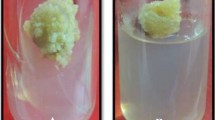Abstract
Because of the explosive increase in world population, a sufficient food supply must be achieved by varietal improvement in the major cereal crops including rice. It is expected that new in vitro techniques incombination with conventional breeding methods may effectively raise the yield potential. On the other hand, there are many environmental problems to be solved world-wide such as, global warming, environmental pollution, ecological destruction, reduction in water supplies and so on. Therefore, it is necessary to rapidly develop new varieties for the future combining of higher yield potential with excellent grain quality, and resistance to both biotic and abiotic stresses for the promotion of sustainable agriculture. Although many efforts have been made to introduce useful traits from wild species to cultivated rice via hybridization, it is still difficult to overcome breeding barriers such as cross incompatibility and hybrid sterility and inviability in practical breeding. Now in vitro techniques are going to make it possible to use genetic manipulation and cell culture and fusion techniques to speed up the breeding process. For sustainable agriculture, it is important to utilize the useful genes from alien species. For this purpose, asymmetric protoplast fusions have already been used successfully to transfer disease resistance in Brassica napus. In this experiment, a high level of resistance to the rice blast disease was transferred from wild species through asymmetric fusions. It is also noted that manipulation of cytoplasmic genomes is possible through asymmetric fusions as shown in the induction of new cytoplasmic male sterility (CMS).
Similar content being viewed by others
References
Aviv, D., P. Arzee-Gonen, S. Bleichman & E. Galun, 1984. Novel alloplasmic Nicotiana plants by 'donor-recipient' protoplast fusion: cybrids having N. sylvestris nuclear genomes and chondriomes from alien species. Mol Gen Genet 196: 244–253.
Brar, D.S. & G.S. Khush, 1997. Alien introgression in rice. Plant Mol Biol 35: 35–47.
Escalante, A., S. Imanishi, M. Hossain, N. Ohmido & K. Fukui, 1998. RFLP analysis and genomic in situ hybridization (GISH) in somatic hybrids and their progeny between Lycopersicon esculentum & Solanum lycopersicoides. Theor Appl Genet 96: 719–726.
Fukui, K., N. Ohmido & G.S. Khush, 1994. Variability in rDNA loci in the genus Oryza detected through fluorescence in situ hybridization. Theor Appl Genet 87: 893–899.
Izhar, S., M. Schlicter & D Swartzberg, 1983. Sorting out of cytoplasmic elements in somatic hybrids of petunia and prevalence of the heteroplasmon through several meiotic cycles. Mol Gen Genet 190: 468–474.
Jacobsen, E., H.J. de Jong, S.A. Kamstra, P.M.M.M. Van Den Berg & M.S. Ramanna, 1995. Genomic in situ hybridization (GISH) and RFLP analysis for the identification of alien chromosomes in the backcross progeny of potato (+) tomato fusion hybrids. Heredity 74: 250–257.
Kadowaki, K.T., T. Suzuki & S. Azama, 1990. A chimeric gene containing the 5 portion of atp6 is associated with cytoplasmic male-sterility of rice. Mol Gen Genet 224: 10–16.
Kamisugi, Y., S. Nakayama, R. Nakajima, H. Ohtsubo, E. Ohtsubo & K. Fukui, 1994. Physical mapping of the 5S ribosomal RNA genes on rice chromosome 11. Mol Gen Genet 245: 133–138.
Kyozuka, J., H. Hayashi & K. Shimamoto, 1987. High frequency plant regeneration from rice protoplasts by novel nurse culture method. Mol Gen Genet 206: 408–413.
Melzer, J.M. & M.A. O'Connell, 1992. Effect of radiation dose on the production of and the extent of asymmetry in tomato asymmetric somatic hybrids. Theor Appl Genet 83: 337–344.
Ohmido, N. & K. Fukui, 1995. Cytological studies of African cultivated rice, Oryza glaberrima. Theor Appl Genet 91: 212–217.
Oono, K., 1985. Putative homozygous mutations in regenerated plants of rice. Mol Gen Genet 198: 377–384.
Song, Y.C. & J.P. Gustafson, 1993. Physical mapping of the 5S rDNA gene complex in rice (Oryza sativa). Genome 36: 658–661.
Tanksley, S.D. & S.R. McCouch, 1997. Seed banks and molecular maps: unlocking genetic potential from the wild. Science 277: 1063–1066.
Walters, T.W. & E.D. Earle, 1993. Organellar segregation, rearrangement and recombination in protoplast fusion-derived Brassica oleracea calli. Theor Appl Genet 85: 761–769.
Wolters, A.M.A., H.C.H. Schoenmakers & M. Koornneef, 1995. Chloroplast and mitochondrial DNA composition of triploid and tetraploid somatic hybrids between Lycopersicon esculentum and Solanum tuberosum. Theor Appl Genet 90: 285–293.
Author information
Authors and Affiliations
Rights and permissions
About this article
Cite this article
Kinoshita, T., Mori, K. In vitro techniques for genomic alteration in rice plants. Euphytica 120, 367–372 (2001). https://doi.org/10.1023/A:1017506100359
Issue Date:
DOI: https://doi.org/10.1023/A:1017506100359




